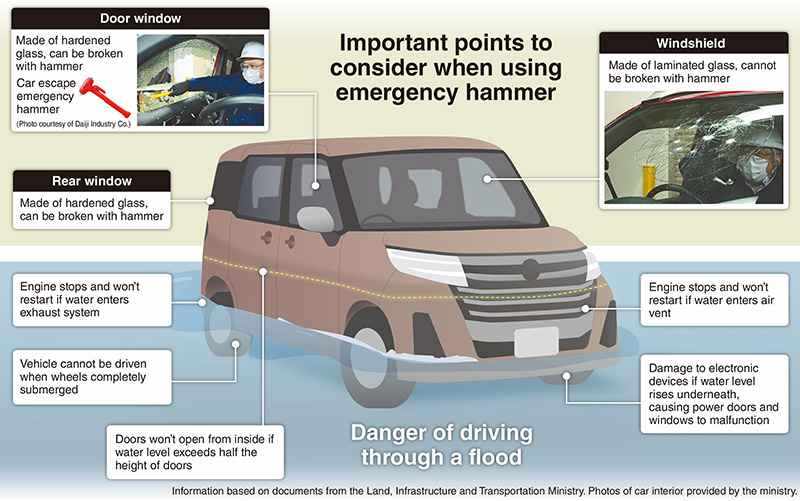What would you do if caught in a flood while driving?

14:53 JST, August 19, 2022
Successive downpours and typhoons in recent years have flooded roads, and people have died in vehicles submerged by flooding.
Drivers must be aware of the dangers of hazardous weather. The Yomiuri Shimbun imagines a series of worsening scenes to help you prepare for and act against dangerous situations and escape from a submerging car.
1, School pickup requested
— Be familiar with local area
Taro, 42, was working from home. During an afternoon coffee break, he received a phone call from his daughter Hanako, 16, a first-year high school student. She said: “It’s raining so hard, and I don’t think I can go home by bicycle. Could you pick me up?”
Taro saw the heavy rain beating against the window. It would take Hanako about 40 minutes to walk home from school, and even with an umbrella it would be difficult.
He remembered the weather report on TV forecasting heavier rain later into the night. He looked at his smartphone and saw that a heavy rain warning alert had come in about an hour earlier. The nearest bus stop was too far from the house, and he was reluctant to drive in low visibility conditions, but still got into his car.
He left home, but the slanting rain affected his view. He used his car navigation system to take the shortest route to the school and came across an underpass. He was annoyed. The water had already reached a high level. It looked impossible to get through. “I should’ve checked for areas of potential flooding when the weather was good,” he said to himself. He turned back to find an alternative route.
2, Abrupt change of course
— Avoid driving through water
Taro used the navigation system to find another route, but he wasn’t sure if it was safe. “I should’ve checked a hazard map to get some ideas of where flooding may occur,” he thought.
He chose a route not too close to a river and set off. The navigation system led him down an unfamiliar one-way street. He continued to drive and saw the entire road ahead was under water. The ground level was getting lower. “It is flooded even here!?” He was annoyed and was about to turn back when he saw the lights of a car approaching from behind.
The dirty water made it difficult to see how deep it was, but Taro decided to drive through it. He thought the water level didn’t look very high, and hit the gas while thinking about his daughter.
Taro soon realized the flooded section was longer than he thought. “I can’t get stuck in the water,” he thought, and tried to drive faster. But the water impeded his car. With the road hidden underwater, each bump that he felt was alarming. “I should have turned back,” Taro thought.
3, Stranded and soaked
— Keep emergency escape tools
After a while, Taro’s car came to a complete stop, apparently because the front wheel had got stuck in a roadside ditch. “I didn’t expect it to suddenly get deep,” he told himself. It was now evening and visibility was poor. The rain continued to fall, and the muddy water submerging the road appeared to be rising further.
Taro tried to open the driver’s window to check outside, but the button didn’t work. He had to open the door and found the rising water had reached a level even with the floor of the car. The water might soon be higher than the bottom of the door frame.
“The door might not open because of the water pressure, and I might get trapped inside the car,” Taro felt uneasy and hurriedly opened the door to get outside. He then thought, “Maybe I should have kept some tools in the car to get out in case I got trapped.”
He sent Hanako a message on the Line communication app, telling her he could not pick her up because his car was stuck in a flood. With water up to his knees, Taro regretted his actions that led to this situation and didn’t know what to do next. He didn’t know how to get his car towed, nor what to do without access to his vehicle.
Be prepared to escape car with emergency hammer
As a precaution, you should make sure you know how to get out of a flooded car.
First, check if the door opens. If it does, open it and get out.
“When the water pressure makes it difficult to open the door, you may find it hard to push using your arms. Kicking [the door] with both feet is effective,” said a member of the Nihon Bousaisi Kai, an association of disaster prevention experts.
If the window is the only option, escape that way. “Grab the car roof with your hands and pull yourself out,” he said.
Keep an emergency hammer inside the car in case the doors and windows won’t open. Auto parts stores sell tools to break windows and cut seatbelts. Products with a JIS mark assure a higher performance.
Door and rear windows are easy to break with a hammer. Laminated glass is often used for the windshield to prevent it from shattering, making it hard to break. Some car models use laminated glass for door windows, too, so it is best to check in advance. The hammer should be kept within reach of the driver’s seat, preferably in the door pocket on the driver’s side.
It is better to avoid starting the engine when the car is flooded or submerged, as this could start a fire by causing a short circuit in the electrical system. The Japan Automobile Federation (JAF) and other road services will tow your vehicle to dealers and maintenance shops.
Choosing adequate car insurance is also important. “Car insurance generally covers repair costs even in the event of water damage from typhoons or floods,” a Tokio Marine & Nichido Fire Insurance Co. spokesperson said. “In some cases, towing costs are also covered, so please check your coverage carefully.”
Some insurance policies also cover the cost of a rental car during the repair.
"JN Specialities" POPULAR ARTICLE
JN ACCESS RANKING






